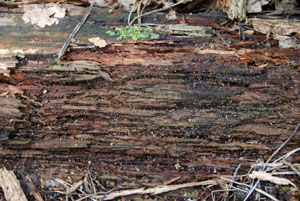Deadwood
Traditionally woodland was kept “clean” by clearing away fallen timber. However, nowadays it is recognised that deadwood has an important part to play in forest management. Deadwood was removed to prevent the transfer of disease and pests – a mistaken belief as it happens, for almost all species which inhabit deadwood are specific to that habitat (“saproxylic”) and will not inhabit living wood. Now deadwood is recognised as an essential part of the forest ecosystem.
While your first image of deadwood might be a fallen tree, there are in fact many types of “deadwood”. Lying thinnings can provide a useful “carpet” for fungus, and dead branches on living trees can make roosts for birds. Crevices and rot holes created by damage to the tree give shelter to a whole host of invertebrates which in turn are food for birds. “Snags” or standing dead trees can provide stable, long term habitats. Native pines, for instance, can take up to 80 years to rot and give a home to a whole host of creatures from the timberman beetle which likes new deadwood, to the crested tit which nests in well-decayed snags and stumps, and capercaillies and ospreys which roost in large dead branches. Birchwood, on the other hand, rots from the inside out creating a hollow tube which is ideal for roosting bats and nesting sites for woodpeckers.
 It is not just within woodlands that deadwood has a part to play. In and at the edge of watercourses it traps organic matter and facilitates its breakdown into food for aquatic invertebrates. It also provides cover for fish and other creatures dwelling at the edge of the river. It can also alter the water flow, creating pools for instance with natural dams. Deadwood is also a feature of natural bog woodlands.
It is not just within woodlands that deadwood has a part to play. In and at the edge of watercourses it traps organic matter and facilitates its breakdown into food for aquatic invertebrates. It also provides cover for fish and other creatures dwelling at the edge of the river. It can also alter the water flow, creating pools for instance with natural dams. Deadwood is also a feature of natural bog woodlands.
In the south-east of England where woodland has been fairly heavily managed, the great storm of 1987 created a mass of fallen timber which led to a resurgence in many saproxylic species. On the whole, providing there are no safety issues and it is not in an overwhelming quantity, the preference now is to leave standing dead trees and fallen limbs where they are, and to stack cut timber. Even artificial “damage” can be created by careful cutting of crevices with a chainsaw.
Further reading is available in the The Forestry Commission’s interesting and comprehensive publication, “Life in the Deadwood”
Comments are closed for this post.
Discussion
After coppicing last year we left loads of piles of dead wood around the clearing – and robins in particular love them! We have left some food in the piles for them in the very cold weather. Mike got some brilliant photos of them on top of the dead wood piles!

Looking for unusual shaped big twigs something that resembles a bonsai wood
Looking for s shaped type twigs or thick branches if that makes any sense
Vivianne Zaidorf
4 November, 2019